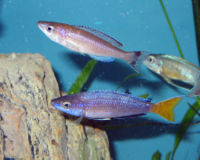Difference between revisions of "Cyprichromis leptosoma"
From The Aquarium Wiki
m |
(No difference)
|
Revision as of 12:36, 6 February 2014
Bright-Finned Slender Cichlid
Cyprichromis leptosoma
208 Litres (55 US G.)
10-11 cm (3.9-4.3")
Freshwater
8.0 - 9.0
23 -25 °C (73.4-77°F)
9-19 °d
1:1-2 M:F
8-12 years
Family
Cichlidae
This animal is available captive bred
Contents
Additional names
- Bright-Finned Slender Cichlid, Slender Cichlid, Sardine Cichlid
Additional scientific names
- Paratilapia leptosoma, Limnochromis leptosoma
Origin
- Hails from 300 miles of lake Tanganyika's eastern coastline, from Kigoma in Tanzania and mpulungu in Zambia. They are found in areas with deep, clean water and rocky shores, where they congregate in schools with thousands of members and feed on plankton.
Sexing
- These fish can take months to color up, but when they do males are instantly recognizable by their bright blue and yellow colors, which have been compared to fruity popsicles! The females are a drab silver color.
Tank compatibility
- An excellent resident for Tanganyikan communities as long as their tank mates are not aggressive; surprisingly, this include tropheus as long as the tropheus are kept in the minimum recommended 12+ group. Do not keep them with frontosa, as cyps are their natural prey in the wild!
Diet
- A carnivore with a surprisingly small mouth and throat. Feed small flakes, pellets, live and frozen food - even adults will take baby brine shrimp!
Feeding regime
- The usual once or twice a day feeding regime will work. They are ravenous eaters, and if you are trying to feed fry in the tank take care that the cyps do not eat it all before the fry can get the food! Do not just drop the food on the water surface, as cyps are mid water feeders and may get bubbles of air stuck in their bodies if they feed at the surface.
Environment Specifics
- Some tall rocks are needed on one side of the aquarium to simulate a ledge, but otherwise cyps need open tanks to give them the necessary swimming room. Like all Tanganyikan cichlids, they are sensitive to water quality and 2 25 percent water changes a week should be considered mandatory.
Behaviour
- A schooling, maternal mouthbrooder cichlid which is found in groups with thousands of individuals in the wild, with 3 types of schools: female and juvenile schools, breeding male schools, and schools consisting of holding females. Sadly this behavior, referred to as 'lekking', cannot be fully emulated in most aquariums, but cyps will otherwise behave as they would in the wild.
- Breeding males hold three dimensional territories which they try to lure females into with a head-down flaring display: if he succeeds, they mate and up to twenty exceptionally large eggs are produced, which are fertilized immediately by the male. The female quickly grabs the eggs - potentially including those of other spawning females - before they sink, and holds them for almost four weeks before releasing enormous, half inch long fry! The fry will take bbs and similar foods from birth and will join the main school when they reach an inch in size.
Identification
- An elongated, sardine like cichlid in which the males have very bright iridescent colors and either a yellow or blue tail depending on the color morph. They can be distinguished from other cyps by their narrower build. This species also has a 'jumbo' variant - likely a separate species, although it is not classified as such - that hits 7 inches in size: it needs a larger tank and should not be mixed with the normal leptosoma for fear of hybridizing.
Pictures
External links
- Fishbase (Mirrors:
 )
)
- Cichlid-Forum "Utinta" Article
- Cichlid-Forum "Mpulungu"
- Cichlid-Forum "Ikola"
- Seriously Fish


